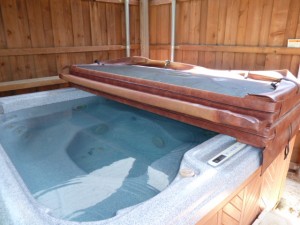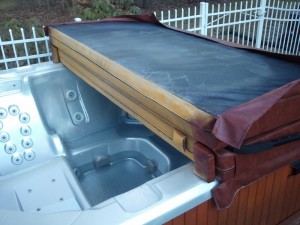We are using chlorine in our hot tub. Recently we have heard it is better to use bromine. What is the story with chemicals as they relate to the spa cover?
Shirl – Chicago, Illinois
Hi Shirl,
Chemical use can dramatically affect the life of your spa cover. In general, bromine is more gentle on the cover than chlorine. Below we will explain the details.
Most hottub lids will end up failing due to water logging. Covers are made with a vapor barrier which is the plastic bag the foam cores are sealed inside of. Unless damaged, the vapor barrier will eventually decay from the chemicals, then fail and let the water vapor inside to the foam cores. When this happens, the foam cores will waterlog and become both heavy and unhealthy.
The first step in delaying this process is to find the best vapor barrier available. Most sellers will list the thickness of their vapor barrier and will offer upgrades to thicker materials. The idea here is that a thicker barrier will take longer to decay and fail, so the cover will last longer. Vapor barriers from different sellers can be compared by their thickness only if they are made from the same materials. Some sellers offer both thicker vapor barriers and barriers upgraded to more decay resistant materials.
This picture shows the vinyl discoloration caused by chemical burn. The areas between the steam stopper pillows, where the chemical vapors can reach, have been discolored and bleached. This is only a visible result of the effects of the chemicals. Imagine, if the chemical vapor is strong enough to burn the vinyl, what has happened to the vapor barrier inside the cover. It is surely decaying as well. Some evidence of this can be seen by the rounded burn area on the bottom of the open half of the cover. This highlights the area of the cover the chemical vapors have reached.
Whether you use chlorine or bromine, an easy method to prevent cover chemical damage is to leave the cover off of the hot tub for one to two hours after the chemicals have been added to the tub. This will provide enough time for the chemicals to largely off gas into the air, and not to damage the cover.
From wikipedia, “Bromine, like chlorine, is used in maintenance of swimming pools, especially spas (hot tubs), where it is generated in situ from a bromide plus hydrogen peroxide. In spas, the high water temperatures render chlorinated water purification and buffering compounds unstable, and bromine compounds may improve the life of the free-halogen antimicrobial.“
This second picture shows discoloration the full length of the long steam stopper, running across the fold under the cover. Although a different topic all together, this is visible proof of how effective a long steam stopper is at keeping heat from escaping through the fold of the cover.
The chemicals you use to keep your hot tub safe and healthy are very important. Consideration of the information presented above will help minimize and counter the effects of these chemicals on the hot tub’s cover.
Happy Tubbing!
Ethel Elliott



